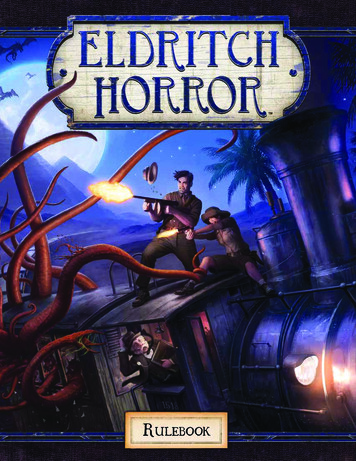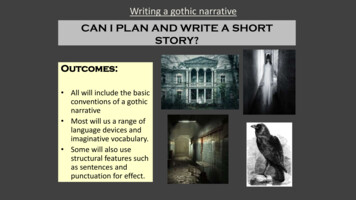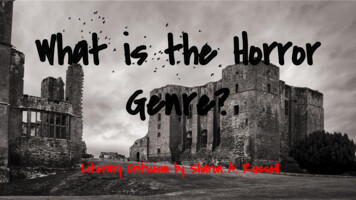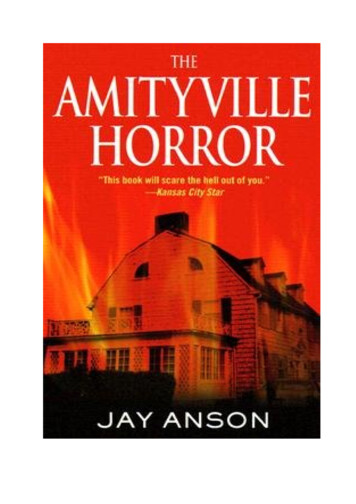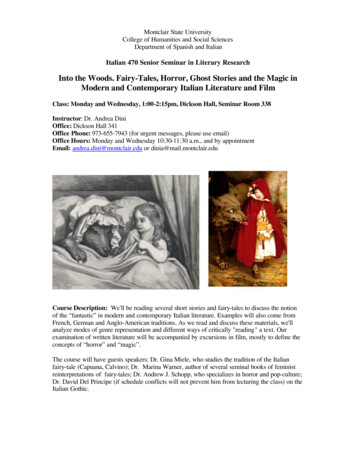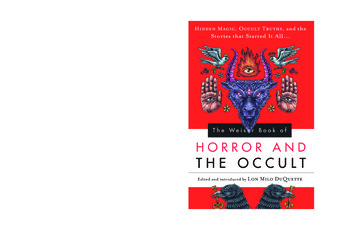
Transcription
Aleister Crowley Ambrose BierceA r t h u r M ac h e n E d g a r A l l a n P o eRobert W. Chambers Ralph Adams CramH . P. L o v e c r a f t D i o n F o r t u n eS i r E d wa r d B u lw e r - L y t t o n B r a m S t o k e rAs DuQuette writes in his introduction, horror takes its time.It creeps in, seeps in, and lingers. These stories will take you hoursto read, but they will stay with you, biting at your heels from theshadows, eternally. Don’t say we didn’t warn you .ISBN: 978-1-57863-572-6U.S. 19.95Edited and Introduced bywww.redwheelweiser.comLon Milo DuQuetteL o n M i l o D u Q uette is a bestselling author and lecturer on such topicsas magick, tarot, and the Western mystery traditions. He is currently USDeputy Grand Master of Ordo Templi Orientis and is on the faculty ofthe Omega Institute in Rhinebeck, NY and the Maybe Logic Academy.Among his many books, he is the author of My Life with the Spirits, UnderstandingAleister Crowley’s Thoth Tarot, and Tarot of Ceremonial Magick. He lives inCosta Mesa, CA, with his beautiful wife Constance. Visit him online at:www.lonmiloduquette.com.T h e We i s e r B o o k o fLooking for a thoughtful fright? Or perhaps a frightful thought?Packed with stories selected by one of today’s leading esoteric scholars,this book will do more than make your toes curl and your skin crawl.These tales reveal hidden truths, inspire forbidden pursuits, anddivulge the secrets of magical initiation in the guise of fiction.Covering topics from rituals to hauntings to the Devil himself, thisone-of-a-kind volume includes selections from:H O R R O R A N D T H E O C C U LTH O R R O R TA K E S I T S T I M E
This edition first published in 2014 by Weiser BooksRed Wheel/Weiser, llcWith offices at:665 Third Street, Suite 400San Francisco, CA 94107www.redwheelweiser.comAll new materials 2014 by Weiser BooksAll rights reserved. No part of this publication may be reproduced or transmittedin any form or by any means, electronic or mechanical, including photocopying,recording, or by any information storage and retrieval system, without permissionin writing from Red Wheel/Weiser, llc. Reviewers may quote brief passages.“The Sea Lure” was first published in The Secrets of Dr. Taverner, copyright 1926, 1989 by The Society of the Inner Light. Used with permission.ISBN: 978-1-57863-572-6Library of Congress Cataloging-in-Publication Data available upon request.Cover design by Barb FisherCover art Symonenko Viktoriia/ShutterstockInterior by Maureen Forys, Happenstance Type-O-RamaTypeset in Mrs. Eaves and FuturaPrinted in the United States of America.EBM10 9 8 7 6 5 4 3 2 1HorrorOccult.indd 67/22/14 5:14 PM
H o rro r Ta k es Its T i m eLon Milo DuQuetteThe oldest and strongest emotion of mankind is fear, and the oldest and strongest kind offear is fear of the unknown. These facts few psychologists will dispute, and their admittedtruth must establish for all time the genuineness and dignity of the weirdly horrible tale as aliterary form.H.P. Lovecraft, Supernatural Horror in Literature“Oh, my sweet summer child,” Old Nan said quietly, “what do you know of fear? Fearis for the winter, my little lord, when the snows fall a hundred feet deep and the ice windcomes howling out of the north. Fear is for the long night, when the sun hides its face foryears at a time, and little children are born and live and die all in darkness while the direwolves grow gaunt and hungry, and the white walkers move through the woods.”George R.R. Martin, A Game of ThronesHorror is the literature of the damned; a demon-child art-form—conceived in the fertile depths of subconscious hell; gestated in thelonely womb of fear and despair; brought to troubled birth by themidwife of tortured obsessions; and reared to grotesque maturityin the prison asylum of a terrified imagination. Horror, to be trulyhorror, must be more than a frightening story. It must be a cloisteredodyssey, a claustrophobic dance with madness. Above all, horror mustbe a traumatic and soul-mutating spiritual experience—sublime, elegant, and terrible.Sounds disturbing, doesn’t it? I hope so. Horror should be disturbing. But, at first glance, classic horror seldom presents itself asthe product of a disturbed mind. On the contrary, some of the bestixHorrorOccult.indd 97/22/14 5:14 PM
works of the genre are introduced by a narrator who seems as saneand rational as you or I—an ordinary mind which, at the moment, ismerely grappling with extraordinary psychological issues with whichwe all can more or less identify. But beware dear reader! Your gentleempathy with the story’s protagonist is a subtle poison that within abreathtakingly few paragraphs disrobes your soul and lulls you intoa poppied sleep. Naked and vulnerable (and now uncertain of yourown sanity), horror draws you irresistibly into the mind of the maincharacter of a nightmare.For me (or anyone who stubbornly refuses to grow up completely)literature doesn’t get better than that.I turned nine years old in July of 1957, and was enduring my second melancholy summer of exile in the uncivilized wilderness ofNebraska.1 I realize the word “exile” probably sounds melodramatic,but I was a very melodramatic child in 1957. Nebraska was for me analien planet, cruel and hostile.I hadn’t been born in Nebraska. I had been kidnapped by my ownparents and taken there against my will. 2 I was a Southern California boy, and I thoroughly enjoyed my first seven years in that hipand sunny fairyland where movies were made; where rock-n-roll wasevolving and the dreams and industries of the “Space Age” made us1 I sincerely apologize to Nebraskans, past and present, who might be offended bymy words, and ask the reader to please be mindful that my comments here aboutNebraska and Nebraskans are merely giving voice to the private, personal, subjective, and immature observations of the high-strung and unhappy nine-year-oldLon Milo DuQuette. They do not necessarily reflect my current objective opinionsof the Great State of Nebraska or her remarkable and resilient citizens. I sincerelyapologize to Nebraskans, past and present, who might be offended by my words.2 Of course I wasn’t actually “kidnapped.” Again, my flair for the overly dramaticis getting the best of me. (That happens, especially when writing about overly dramatic subjects like horror stories.) My family moved from Southern California toNebraska so that my father could start a new business. I was nonetheless traumatizedby the move and resisted every phase of the process.x The Weiser Book of Horror and the OccultHorrorOccult.indd 107/22/14 5:14 PM
all feel like citizens of a bright and gleaming future. The family’smove to Nebraska in 1955 was in my eyes a doleful exodus back tothe dark ages—a “trail of tears” from a twentieth-century beach paradise to a nineteenth-century prairie hell. Powerless to change mycircumstances, I pouted and steeped in a bitter broth of self-absorbeddiscontentment.I hated Nebraska. I hated Nebraskans. I hated the way they talked.I hated the way they laughed about butchering animals. I hated the waythey preached about their wrathful God—a God who hated Negroesand Chinese (even though there wasn’t a Negro or Chinese personwithin a hundred miles of our provincial town); a God who wouldcondemn little boys to the flames of eternal torment just for the sinof not believing in a God who hated Negroes and Chinese. Most of all,I hated the way Nebraskans, young and old, actually took smug pridein their own lack of sophistication. They wore their ingenuousnesslike a badge of honor, and rudely ridiculed and bullied anyone elsewho did not also proudly clothe themselves with the same coarse robeof premeditated ignorance.I admit this must sound terribly unkind. “Hate” is a strong andunhealthy passion, especially for a nine-year-old boy. But hate springsfrom fear (real or imagined), and in my young mind there was muchto fear in Nebraska. Even as a youngster I sensed a palpable darkness;a prairie madness; a nameless evil brooding just underneath the surface of the bib overalls and cotton house dresses; a slumbering beastjust waiting to be awakened by the kiss of alcohol or jealousy or greedor lust; an evil that is ever mindful that the nearest policeman is manymiles (and perhaps hours) away; a black and primitive wickedness thattakes poisonous root in the solitary psyche of those who toil alonein the earth from dawn to dusk, season after season, year after year;an evil that smothers in the heart all breath of human compassionor empathy for the pain and terror they inflict daily on the helplessbeasts they breed for slaughter or the children they breed for labor andwar; a twisted and perverse evil that feeds on guilt and self-loathing;an evil that incubates in the deafening silence of sweltering summerHorror Takes Its Time xiHorrorOccult.indd 117/22/14 5:14 PM
nights or the perpetual darkness of winter and hideously hatches likea basilisk egg into monstrous acts of rape and incest, and murder,and suicide.The houses themselves are possessed of dark subconscioussecrets—indeed, they are built upon them. Unlike the sunny anduninsulated bungalows of Southern California, Nebraska houseshide their own dungeons. Large as the footprint of the house itself,these cinder block chambers (the natives call them “basements”) offera modicum of insulation from the frozen sod of winter, and an areaof damp coolness from the blistering heat of summer. Basements alsoprovide residents a dark hole in the ground in which to cower fromthe whirling death clouds called tornadoes—tangible wind devils thatregularly strike down from pus-green clouds and sweep across theearth, bringing grotesque death and destruction to anything andeveryone in their path.Yes. There was much for a young man to fear in Nebraska. Iwas lonely, depressed, and morose. One sweltering humid summermorning I became so desperately bored I did something unthinkablefor a nine-year-old boy in Nebraska.I found something to read.That morning I lingered in my sweat-soaked bed until I knewI was alone in the house. I got up and turned on our old Raytheontelevision set in the living room but could only get a scattered signalof a “farm report.” Like electricity and indoor toilets, television wasnew to rural Nebraska, and the few broadcast stations in operationwere very far away. Reluctantly, I switched off the crackling televisionand turned my attention to the living room bookcase. I looked forsomething—anything—that might alleviate my ennui or titillate myidle brain.The family library had a few things that might distract me. Myfather was a pretty interesting guy (a native Californian and veryun-Nebraskan). He valued education and wanted his sons to cherishbooks, so he had recently purchased a new set of World Book Encyclopedia to display next to a few old sets of matched volumes of literature.xii The Weiser Book of Horror and the OccultHorrorOccult.indd 127/22/14 5:14 PM
I figured the encyclopedia would be too much like homework, so Iturned my attention to an old twenty-volume set of the World’s GreatestLiterature.3At first glance The Last of the Mohicans looked like it might be fun, but Isoon discovered it much too grown-up and difficult. I finally settled onvolume 8 of the series, Tales of Mystery and Imagination, by Edgar Allan Poe. Iopened it up and saw to my delight that it was a collection of short storieswith titles that were absolutely irresistible to a miserable nine-year-oldboy: “The Premature Burial,” “The Masque of the Red Death,” “TheTell-Tale Heart,” and so on. Premature burials and red death soundedvery promising indeed, but back in California I had actually seen aterrifying cartoon called “The Tell-Tale Heart” at the old LakewoodTheater. 4 I recalled that my mother became very upset with my olderbrother Marc for taking “little Lonnie” to see such an adult and disturbing film. I poured myself a glass of buttermilk, plopped down inthe big chair by the open window, and opened the book.Once I started to read, however, I knew I was way out of my depth.There were lots of big words, incomprehensible foreign languagephrases and epigrams, and geographic references. Every other sentence seemed to make reference to some ancient legend or myth orclassic poem. I was forced to actually use the dictionary and encyclopedia just to plod my way through the first story, “The Pit and the Pendulum.” But I eventually did get through it, and after I closed the bookI realized I had become someone else—someone I liked who could usethe dictionary and encyclopedia. I learned about the horrors of theSpanish Inquisition (How delightfully evil was that!); I was exposed forthe first time to the melodically elegant use of the English language;53 Spencer Press, 1936. He must have had the books since before he married Mom.4 The Tell-Tale Heart, directed by Ted Parmelee, narrated by James Mason, screenplayby Bill Scott and Fred Grable. (1953; Columbia Pictures).5 I had to read Poe so deliberately that I felt as though I was reading aloud. In mysoul, Poe’s voice carried the gentlest lilt of a fine Southern gentleman and the tortured desperation of my favorite actor, Vincent Price.Horror Takes Its Time xiiiHorrorOccult.indd 137/22/14 5:14 PM
most importantly, I discovered I was capable of being touched by art—capable of being possessed by passion. My ennui lifted and was replacedby a pre-adolescent worship of the macabre and the genius and witof its creators. This passion has yet to subside. I spent the rest of thatsummer with Poe . . . and the dictionary, and the World Book Encyclopedia.Ironically, the same nineteenth-century-esque liabilities I despisedabout 1950s Nebraska life proved to be priceless assets of atmospherethat allowed me to conjure the perfect reading environment to savorthe ecstasy of classic horror.Horror takes its time, and to properly appreciate it you must also takeyour time. It has a pace, a slow, incessant rhythm—like your ownheartbeat, or your own breath. After all, the great innovators of theart were writers of the Gilded Age who wrote for a nineteenth- andearly twentieth-century audience.6 Nebraska in 1957 had both herfeet planted firmly in the nineteenth and early twentieth centuries.That summer morning in 1957 could have just as easily been 1857,accompanied by the same soundtrack of bucolic silence; the same lightsearing through the same sun-stained yellow window shades; no hintof modern objective reality, no diversions of bustling civilization;no diversions of airplanes roaring overhead, no freeways in the distance, no sirens, no television, no radio, no air-conditioner; only thewhite noise of a million cicadas and the hiss of my own blood runningthrough my brain, the incessant swing of the pendulum of an ancientclock, the barking of a distant dog, the cawing of a crow, the almostimperceptible whisper of the delicate film of curtains as they billowedgently toward me like the gossamer negligée of a lovesick ghost.This was the background music of my honeymoon with horror—playing as the honey-sweet words of Edgar Allan Poe, lugubriouslywoven elegant phrases from the age of gilded manners into a symphony of tortured rapture. Only had I been obliged to read the yellowing pages by the light of a whale oil lamp could my anachronisticreading experience have been more exquisitely atmospheric.6 The offerings in this anthology date from 1851 to 1922.xiv The Weiser Book of Horror and the OccultHorrorOccult.indd 147/22/14 5:14 PM
I was so lucky.Today most of us find it almost impossible to recapture the sepiatoned world that best conducts horror from the page to the soul.Twenty-first-century readers, spoiled by spectacular special effectsof the cinema, demand instant gratification from the written word—explosive shocks and gore-splattered attacks upon the senses. We nolonger allow ourselves time to refine the rapture of terror. We wolfdown the junk food snacks of violence and carnage when, with justa little patience, we could leisurely savor a rich and soul-satisfyingbanquet of elegant horror. We are missing so much.That summer with Poe and my newly awakened love for the writtenword would eventually have profound effects upon my life, the mostobvious being my eventual career as a writer. Writing is not only what Ido for a living, it is my art, my joy, my voice, my meditation, my prayer,my confession, my declaration of independence, my act of worship, mysong of self-awareness. My profession, however, has taken many yearsto evolve and develop. My 1957 boyhood love affair with horror hadmore immediate and dramatic consequences. Simply put—I woke up.Poe’s narrative voice clearly revealed to me that I possessed myown narrative voice. That hot summer morning, my consciousnessinstantly expanded. I no longer just passively saw or heard or smelled orfelt the things around me. I woke up and became consciously aware thatI was seeing and hearing and smelling and feeling the things aroundme. I became at once the observer and the observed of my own movie,and like the voice-over narration in a film-noir detective story I beganto tell myself the bedtime story of my own existence, and the narrationcontinues to this moment.Thank you, Edgar Allan Poe. Thank you, horror literature.The genre of classic horror has also changed the world. It can beargued that horror is the mother of science fiction—and that sciencefiction has molded the future and touched the consciousness of countless millions of fans who now have given themselves permission todream like gods. In its way, horror is the grandmother of theoreticalmathematics, quantum physics, and the mutation of intelligence in thisHorror Takes Its Time xvHorrorOccult.indd 157/22/14 5:14 PM
corner of the galaxy. But it all had to start somewhere, and the editorsof this anthology have labored lovingly to pay homage to the foundingfathers of art form. Some of them, like Edgar Allan Poe, or H.P. Lovecraft, or Bram Stoker, or Sir Arthur Conan Doyle, require little orno introduction. But others are perhaps less familiar to you. We haveprovided the briefest of biographical sketches for all our authors at thebeginning of each selections, but I would like to take this opportunityto write a few extra words about three of the stars of our production whoalso deserve, in my opinion, to be recognized as founding fathers of horror:Sir Edward Bulwer-Lytton, who I believe should be creditedwith establishing early in the nineteenth century the archetypalform and devices of the horror genre;Robert W. Chambers, who late in the nineteenth century brokethe space-time membrane of gothic horror and smashed openthe doors of our subconscious—the same doors from which H.P.Lovecraft’s primordial “Old Ones” would ooze out, forcing us tocower before our shadow souls;and Aleister Crowley, a real-life, unapologetic black magician whoearly in the twentieth century rolled up his sleeves and did battlewith those shadows to turn demons of darkness into angels of light.Sir Edward Bulwer-Lytton (1803–1873)Have you ever heard these phrases?“It was a dark and stormy night . . . ” or,“The pen is mightier than the sword . . . ” or,“Pursuit of the almighty dollar”?These familiar clichés first poured forth from the pen of SirEdward Bulwer-Lytton, the prolific English playwright, poet, andnovelist. As might be expected of a gentleman of his breeding, thexvi The Weiser Book of Horror and the OccultHorrorOccult.indd 167/22/14 5:14 PM
noble Lord Lytton pursued these literary diversions as an amateurwhile he busied himself with the serious duties of serving his Queen(Victoria) as Secretary of State for the Colonies and a wide assortment of otherstiff-collared diplomatic and political responsibilities. He publishedhis first book of poems in 1820, and in 1828, when his semi-titillating essay on the whimsical subject of nineteenth-century dandyism wasreleased, it was clear to the reading public that here was a fellow whocould be wryly entertaining as well as erudite.While his occult tales and horror stories have become favorites oflovers of the mysterious and macabre, Lytton’s most publicly belovedand familiar works remain his post-biblical epic, The Last Days of Pompeii(1834), which has over the years captured the imagination of filmmakers; and his dramatic historical fiction, Rienzi (1835), which Richard Wagner turned into an enduring opera. His popularity with thegeneral public notwithstanding, Lord Lytton deserves serious recognition as one of the primary godfathers of horror. This enduringadmiration attests to his skill with words, but even more impressiveare his impeccable credentials among serious occultists.Although empirical evidence is absent, Lytton is said to have beenan initiate of one or more of the mysterious continental magical secretsocieties that obliquely claimed they were of ancient Rosicrucian origins. He was almost certainly the friend and confidant of the greatFrench magician, Alphonse Louis Constant (Eliphas Levi, 18101875), the father of modern ceremonial magic.As a young member of the Rosicrucian Order AMORC, I wasinstructed by my elder adepts (in no uncertain terms) that I was toread and study the works of Lord Lytton, especially his occult story Zanoni.7Written in 1842 (a full generation before the founding of Madam Blavatsky’s Theosophical Society or the Hermetic Order of the Golden7 Read my notes on Zanoni by purchasing an electronic copy of Zanoni, Books One,Two, and Three, published as digital books as part of the Magical Antiquarian CuriosityShoppe (A Weiser Books collection!).Horror Takes Its Time xviiHorrorOccult.indd 177/22/14 5:14 PM
Dawn), the opening words of Zanoni can be interpreted as a Rosicrucian confession from Lord Lytton himself:It so chanced that some years ago, in my younger days, whether ofauthorship of life, I felt the desire to make myself acquainted withthe true origins and tenets of the singular sect known by the nameof Rosicrucians.The plot of Zanoni is a darkly appealing love story that inaugurates all the genteel devices of classic horror-love that we will (afew years later) recognize in the works of Edgar Allan Poe, RobertW. Chambers, and others. But the text of Zanoni also reveals (tothe trained eye) the language of a fellow occultist. In fact, it isclear that Zanoni could not possibly have been written by anyoneother than a bona fide initiate of the mysteries. The story even makesindirect references to a magic book—a book that is undoubtedly thevery real tome known to scholars today as The Book of Abra-Melin.8 Thislandmark occult grimoire (c. 1378) would remain untranslatedand unknown to the English-speaking world (or indeed anyonebut the most knowledgeable and serious student of the occult) until1888 when Golden Dawn adept S.L. MacGreggor Mathers translated fragments of the text, which he found in the Bibliotheque del’Arsenal in Paris.The Book of Abra-Melin is considered by many to be the RosettaStone of Western Magick, elevating the misunderstood superstitions of the mediaeval sorcerers to a spiritual science as sacred andviable as the self-transformational traditions of Eastern mysticism.As it would seem, His Lordship, Sir Edward Bulwer-Lytton—dandy, diplomat, and novelist—was rubbing elbows on a regularbasis with very same mystics and magicians who not only knew ofthe book’s existence but were intimately familiar with its contentsand significance.8 Abraham Von Worms, The Book of Abramelin, ed. Georg Dehn, trans. Steven Guth,foreword by Lon Milo DuQuette (Lake Worth, FL: Nicholas Hays, Inc., 2006).xviii The Weiser Book of Horror and the OccultHorrorOccult.indd 187/22/14 5:14 PM
It is clear to me that where secret occult mysteries and practices areconcerned it was not a case of Lord Lytton gleaning his occult knowledge from nineteenth-century English Rosicrucian pretenders, butone of nineteenth-century “Rosicrucians” getting their occult knowledge from him!While we heap praise on Lytton for being a founding father ofhorror, we must also credit him for helping introduce the world to thegenre of science fiction. His 1871 novel The Coming Race would prove to bea breathtaking and disturbing look into the future. Unfortunately,early in the twentieth century the imaginative ideas put forth in TheComing Race would be seized and distorted into a monstrous vision bythe madmen of Germany’s Third Reich, and employed like somemalevolent conjuration to invoke a great demon upon the earth inthe form of the genocidal terrors of the Second World War. No horrorfiction story can possibly compare to such unimaginable evil—suchincalculable pain and death suffered by millions upon millions ofour fellow human beings.Of course, I am not suggesting that we blame Lord Edward Bulwer-Lytton for the genocidal horror of the Holocaust. However, we wouldall do well to be mindful of Lytton’s own words, “The pen is mightierthan the sword,” and be aware of the awesome power the written wordhas to effect changes in human consciousness—for good or for ill.Robert W. Chambers (1865–1933)If H.P. Lovecraft is the Christ of horror, then most assuredly Robert W.Chambers was his John the Baptist.Recently it was my privilege to introduce and curate the seriesof short stories first published in 1895 under the collective title TheKing in Yellow by Robert W. Chambers.9 To avoid paraphrasing myself,9 Robert W. Chambers, Yellow Sign, An Excerpt from the King in Yellow: The King In Yellow series,Magical Antiquarian Curiosity Shoppe, A Weiser Books Collection, Introduction by Lon MiloDuQuette (San Francisco, CA: Weiser Books, 2012).Horror Takes Its Time xixHorrorOccult.indd 197/22/14 5:14 PM
I append a portion of my introduction below. While I refer specifically to The King in Yellow, my observations of Chambers’ style, technique,and imagination apply also to this book’s Chambers selection, “TheMessenger.”Perhaps you have heard of The King in Yellow? No? Neither had I until afew years ago, when a filmmaker contacted me and informed me hewas making a film of The King in Yellow and asked if I would be interested in appearing in a cameo role in the production. Before I gavehim my answer (the project was later abandoned), I did a bit of digging and discovered a most remarkable treasure—a terrifying workof American horror that predates by a quarter century the first shortstory by H.P. Lovecraft. Indeed, The King in Yellow by Robert W. Chambers is arguably the archetypal inspiration for what would becomean entire genre of horror fiction for which the immortal Lovecraftis ultimately credited.Robert W. Chambers (1865-1933) is not exactly a household name,but that has not always been the case. Late in his career his romanticnovels and historical fictions were wildly popular, his books bestsellers, his magazine installments eagerly awaited. For a time hewas considered the most successful American literary figure of theday. Yet his later and lighter offerings, while bringing him fameand modest fortune, are forgettable bonbons when compared tothe strong meat and innovative brilliance of his horror fiction. Themost notable of all his work is The King in Yellow, a collection of shortstories whose plots are loosely connected to an infamous imaginarybook and play of the same title banned universally because of itsominous tendency to drive mad those who read it or came in contact with it. Indeed, the terror begins immediately, with the readerunsure whether or not madness and suicide will be the price he orshe will pay for turning the page.I was a bit disoriented when I began reading The King in Yellow’s opening story—a dizzying effect that I’m sure Chambers intended toinduce in the minds of his “gay-nineties” readers. The tale, called“The Repairer of Reputations,” takes place in the science fiction“future” of a 1920s New York City, a metropolis of street names,parks, and landmarks familiar to us still today, which Chambersmeticulously paints from his rich palette of images (he was, afterall, a classically trained and skilled artist and designer). However,xx The Weiser Book of Horror and the OccultHorrorOccult.indd 207/22/14 5:14 PM
there is something disturbingly tweaked with the entire milieu ofthe story. It all takes place in a utopian and prosperous post-CivilWar America—a blend of aristocratic republic and military dictatorship that could have easily evolved from the strange bed-fellowsof the Gilded Age’s contending movements: nationalistic laissez-faire capitalism and the liberal yet pragmatic ideals of socialprogressivism. From the opening lines, we are instantly plungedinto an alternate reality where the comfortable and familiar pasthas been slightly altered and we are forced to confront the infinite“what ifs” of history—and in doing so calling into question theobjective reality of the present.Nestled within this surreal environment, we are introduced to awell-spoken narrator who at first seems to be a faithful servant ofthe truth, but who will soon give us reason to doubt both his sanityand our own. But I won’t spoil that for you.Like Lovecraft would do decades later, Chambers allows the reader’s own imagination to do the heavy lifting of terror. Cassilda’sSong, which serves as the epigram for the entire work, is supposedlyclipped from Act I, Scene 2 of the play, The King in Yellow, and withoutburdening the reader’s imagination with concrete certitudes, conjures images of strange locales and vistas not of this earth, indeed,not of this universe, and only hints of characters of unspeakablepower and horror.Along the shore the cloud waves break,The twin suns sink beneath the lake,The shadows lengthenIn Carcosa.Strange is the night where black stars rise,And strange moons circle through the skiesBut stranger still isLost Carcosa.Songs that the Hyades shall sing,Where flap the tatters of the King,Must die unheard inDim Carcosa.Horror Takes Its Time xxiHorrorOccult.indd 217/22/14 5:14 PM
Song of my soul, m
as magick, tarot, and the Western mystery traditions. He is currently US . Understanding Aleister Crowley's Thoth Tarot, and Tarot of Ceremonial Magick. He lives in Costa Mesa, CA, with his beautiful wife Constance. Visit him online at: www.lonmiloduquette.com. This edition first published in 2014 by Weiser Books Red Wheel/Weiser, llc

